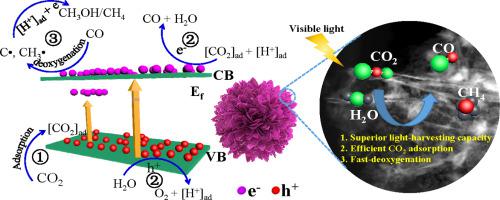当前位置:
X-MOL 学术
›
Chin. J. Catal.
›
论文详情
Our official English website, www.x-mol.net, welcomes your feedback! (Note: you will need to create a separate account there.)
Structural engineering of 3D hierarchical Cd0.8Zn0.2S for selective photocatalytic CO2 reduction
Chinese Journal of Catalysis ( IF 16.5 ) Pub Date : 2021-01-01 , DOI: 10.1016/s1872-2067(20)63623-3 Lei Cheng , Dainan Zhang , Yulong Liao , Jiajie Fan , Quanjun Xiang
Chinese Journal of Catalysis ( IF 16.5 ) Pub Date : 2021-01-01 , DOI: 10.1016/s1872-2067(20)63623-3 Lei Cheng , Dainan Zhang , Yulong Liao , Jiajie Fan , Quanjun Xiang

|
Abstract The solar-driven catalytic conversion of CO2 to useful chemical fuels is regarded as an environmentally friendly approach to reduce the consumption of fossil fuels and mitigate the greenhouse effect. However, it is highly intriguing and challenging to promote the selectivity and efficiency of visible-light-responsive photocatalysts that favor the adsorption of CO2 in photoreduction processes. In this work, three-dimensional hierarchical Cd0.8Zn0.2S flowers (C8Z2S-F) with ultrathin petals were successfully synthesized through an in-situ self-assembly growth process using sodium citrate as a morphology director. The flower-like Cd0.8Zn0.2S solid solution exhibited remarkable photocatalytic performance in the reduction of CO2, generating CO up to 41.4 μmol g−1 under visible-light illumination for 3 h; this was nearly three times greater than that of Cd0.8Zn0.2S nanoparticles (C8Z2S-NP) (14.7 μmol g−1). Particularly, a comparably high selectivity of 89.9% for the conversion of CO2 to CO, with a turnover number of 39.6, was obtained from the solar-driven C8Z2S-F system in the absence of any co-catalyst or sacrificial agent. Terahertz time-domain spectroscopy indicated that the introduction of flower structures enhanced the light-harvesting capacity of C8Z2S-F. The in situ diffuse reflectance infrared Fourier transform spectroscopy unveiled the existence of surface-adsorbed species and the conversion of photoreduction intermediates during the photocatalytic process. Empirical characterizations and predictions of the photocatalytic mechanism demonstrated that the flower-like Cd0.8Zn0.2S solid solution possessed desirable CO2 adsorption properties and an enhanced charge-transfer capability, thus providing a highly effective photocatalytic reduction of CO2.
中文翻译:

用于选择性光催化 CO2 还原的 3D 分级 Cd0.8Zn0.2S 的结构工程
摘要 太阳能驱动的二氧化碳催化转化为有用的化学燃料被认为是一种减少化石燃料消耗和减轻温室效应的环保方法。然而,提高有利于在光还原过程中吸附 CO2 的可见光响应光催化剂的选择性和效率是非常有趣和具有挑战性的。在这项工作中,通过使用柠檬酸钠作为形态导向器的原位自组装生长过程成功合成了具有超薄花瓣的三维分层 Cd0.8Zn0.2S 花(C8Z2S-F)。花状Cd0.8Zn0.2S固溶体在还原CO2方面表现出显着的光催化性能,在可见光照射下3小时产生高达41.4 μmol g-1的CO;这几乎是 Cd0.8Zn0.2S 纳米粒子 (C8Z2S-NP) (14.7 μmol g-1) 的三倍。特别是,在没有任何助催化剂或牺牲剂的情况下,从太阳能驱动的 C8Z2S-F 系统获得了 89.9% 的相对较高的 CO2 转化为 CO 的选择性,转化率为 39.6。太赫兹时域光谱表明花结构的引入增强了 C8Z2S-F 的光捕获能力。原位漫反射红外傅里叶变换光谱揭示了光催化过程中表面吸附物质的存在和光还原中间体的转化。光催化机理的经验表征和预测表明,花状 Cd0.8Zn0.
更新日期:2021-01-01
中文翻译:

用于选择性光催化 CO2 还原的 3D 分级 Cd0.8Zn0.2S 的结构工程
摘要 太阳能驱动的二氧化碳催化转化为有用的化学燃料被认为是一种减少化石燃料消耗和减轻温室效应的环保方法。然而,提高有利于在光还原过程中吸附 CO2 的可见光响应光催化剂的选择性和效率是非常有趣和具有挑战性的。在这项工作中,通过使用柠檬酸钠作为形态导向器的原位自组装生长过程成功合成了具有超薄花瓣的三维分层 Cd0.8Zn0.2S 花(C8Z2S-F)。花状Cd0.8Zn0.2S固溶体在还原CO2方面表现出显着的光催化性能,在可见光照射下3小时产生高达41.4 μmol g-1的CO;这几乎是 Cd0.8Zn0.2S 纳米粒子 (C8Z2S-NP) (14.7 μmol g-1) 的三倍。特别是,在没有任何助催化剂或牺牲剂的情况下,从太阳能驱动的 C8Z2S-F 系统获得了 89.9% 的相对较高的 CO2 转化为 CO 的选择性,转化率为 39.6。太赫兹时域光谱表明花结构的引入增强了 C8Z2S-F 的光捕获能力。原位漫反射红外傅里叶变换光谱揭示了光催化过程中表面吸附物质的存在和光还原中间体的转化。光催化机理的经验表征和预测表明,花状 Cd0.8Zn0.


























 京公网安备 11010802027423号
京公网安备 11010802027423号